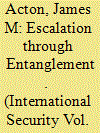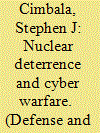| Srl | Item |
| 1 |
ID:
161211


|
|
|
|
|
| Summary/Abstract |
Nonnuclear weapons are increasingly able to threaten dual-use command, control, communication, and intelligence assets that are spaced based or distant from probable theaters of conflict. This form of “entanglement” between nuclear and nonnuclear capabilities creates the potential for Chinese or Russian nonnuclear strikes against the United States or U.S. strikes against either China or Russia to spark inadvertent nuclear escalation. Escalation pressures could be generated through crisis instability or through one of two newly identified mechanisms: “misinterpreted warning” or the “damage-limitation window.” The vulnerability of dual-use U.S. early-warning assets provides a concrete demonstration of the risks. These risks would be serious for two reasons. First, in a conventional conflict against the United States, China or Russia would have strong incentives to launch kinetic strikes on U.S. early-warning assets. Second, even limited strikes could undermine the United States' ability to monitor nuclear attacks by the adversary. Moreover, cyber interference with dual-use early-warning assets would create the additional danger of the target's misinterpreting cyber espionage as a destructive attack. Today, the only feasible starting point for efforts to reduce the escalation risks created by entanglement would be unilateral measures—in particular, organizational reform to ensure that those risks received adequate consideration in war planning, acquisition decisions, and crisis decisionmaking. Over the longer term, unilateral measures might pave the way for more challenging cooperative measures, such as agreed restrictions on threatening behavior.
|
|
|
|
|
|
|
|
|
|
|
|
|
|
|
|
| 2 |
ID:
154702


|
|
|
|
|
| Summary/Abstract |
Nuclear deterrence and cyber war seem almost antithetical in their respective intellectual pedigrees. Nuclear weapons are unique in their ability to create mass destruction in a short time. Information or “cyber” weapons, at least for the most part, aim at sowing confusion or mass disruption instead of widespread physical destruction. Nevertheless, there are some intersections between cyber and nuclear matters, and these have the potential to become troublesome for the future of nuclear deterrence. For example, cyber attacks might complicate the management of a nuclear crisis. As well, information attacks on command-control and communications systems might lead to a mistaken nuclear launch based on false warnings, to erroneous interpretations of data or to panic on account of feared information blackout. It is not inconceivable that future nuclear strike planning will include a preliminary wave of cyber strikes or at least a more protracted “preparation of the battlefield” by roaming through enemy networks to plant malware or map vulnerabilities.
|
|
|
|
|
|
|
|
|
|
|
|
|
|
|
|